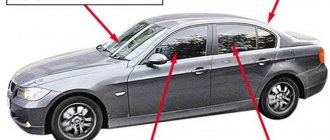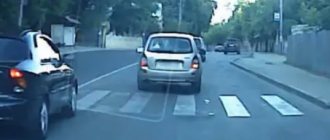Removable - what is it?
Already from the name it becomes clear that such tinting can be removed independently and without any problems. Today the Internet is full of advertisements for the sale of removable tinting. What these sellers offer:
- double windows, one of which is tinted and can be lowered regardless of the second;
- monopolycarbonate plastic, which is about 1 mm thick and sticks to the main glass;
- curtains that have a perforated surface - this is the most common removable tinting;
- silicone tint, in the form of an adhesive film that can be reused.
Installation Tips
Car owners often cover the rear window with a regular film, and install removable silicone tint on the front windows.
With this approach, for maximum aesthetics and matching tones, it is necessary to follow the proportions below and use materials of certain brands:
- If a slight darkening of the interior is required, a Creative product is installed on the front windows by 20%, and a film from the manufacturer Llumar ATR is used on the rear windows by 15%.
- To darken the windows in the car interior as much as possible, you need to use Creative tint material on the front windows, but at 35%. As for the remaining windows, they are tinted with Llumar Bronze by 20%.
The use of the schemes discussed above ensures an aesthetic appearance, excellent visibility and the highest level of comfort in the cabin.
What do the traffic rules say and is it prohibited?
There is, of course, no such term in the 2021 Road Traffic Rules, but in the Basic Regulations for the admission of vehicles to operation there is a List of faults and conditions under which the operation of a vehicle is prohibited, and that’s where it is mentioned about additional items or glass coatings that restrict visibility from the driver's seat.
The note to paragraph 7.3 of the List of faults states the following:
It is allowed to use tinted glass (except for mirror glass), the light transmission of which complies with GOST 5727-88. It is allowed to use curtains on the windows of tourist buses, as well as blinds and curtains on the rear windows of passenger cars if there are external rear-view mirrors on both sides.
Of course, our article is about a toner that does not comply with the above GOST, otherwise there would be no point in finding out its legality.
Based on the above, it becomes clear that additional items or covering the glass with removable tinting is prohibited, since clause 7.3 of the List of Faults is violated, and liability is provided for its violation.
Removable tinting and traffic police (traffic police)
In 2012, traffic police officers received an additional reason to stop a car - window tinting that does not meet the requirements of GOST 5727-88 is a sufficient reason to punish the owner of the vehicle. Already known to many, GOST prescribes that the light transmittance of the windshield should be at least 75% of the luminous flux, for front side windows - from 70% or more. In addition, the State Standard limits the possibility of applying a sun protection strip: its width should not be more than 14 cm, and the light transmission should not be lower than 75% indicated for the entire windshield. In this regard, many drivers use removable static tinting, window curtains instead of tinting, or plastic tinting.
In fact, in 2012, traffic police inspectors were able to preliminarily identify an infringing vehicle based on a simple sign - the presence of any tinting on the windshield and front side windows. Since removable tinting affects the light transmittance of the windows of the vehicle in use, it can also cause a fine.
Every driver knows that preliminary determination of the presence of tinting “by eye” is not a sufficient reason for a fine. To confirm the accusation, a traffic police officer must measure the light transmission of the front side and windshields (darkening of the rear and rear side windows is not standardized by GOST). Removable silicone tinting or removable plastic tinting must be on the glass during measurements, and how to avoid this is up to the driver.
For measurements to be considered correct, they must be made under certain conditions. GOST 27902-88 prescribes the following rules for measuring the light transmittance of glass:
- The air temperature should be from +15 to +25°C;
- Relative humidity should not exceed 80% and be not lower than 40%;
- The atmospheric pressure indicator should be in the range from 86 to 106 kPa.
In fact, the Ministry of Internal Affairs is adopting new tools, which are promptly added to the list of approved ones for use. The operating conditions of new equipment, indicated in its technical data sheet, may differ significantly from those indicated above. An owner operating a car with tinted windows needs to be prepared for this.
In fact, the following recommendations can be considered the only correct ones in the event of a discussion with a traffic police inspector regarding window tinting:
- Remove removable tinting or curtains on the windows instead of tinting before measuring the light transmission of the glass, and, preferably, unnoticed by the traffic police inspector;
- Always request the equipment used (glass light transmission meter, as well as instruments for measuring temperature, humidity, atmospheric pressure) for a visual inspection for external signs of damage;
- Checking the presence and integrity of seals on equipment;
- Checking technical documentation, which indicates the possibility of using a specific type of equipment in accordance with GOST standards, metrological verification certificates, verification of serial numbers;
- Monitoring the correctness of glass light transmission measurements: the glass must be clean (the glass must be wiped by the inspector making the measurements), the emitter must be placed outside the car, the indicator of the measurement result must be visible to the driver.
Existing rules suggest issuing a fine of 500 rubles to the driver. Reality often destroys the hopes of some owners that using removable tint is guaranteed to save them from a fine. The only guaranteed effective method of preventing punishment is unquestioning compliance with State requirements (GOST 5727-88).
Requirement or requirement for removable toner
Our law enforcement officers have gone further in the fight against tinting. In addition to the fine provided for by the Code of Administrative Offenses, they began to issue (issue) a requirement (order) to drivers held accountable for this offense.
The text of these documents may vary, but the meaning is that the police officer demands that the driver no longer break the law and eliminate the existing violation, that is, remove the tint.
If the driver does not comply with this requirement, he may be charged under Art. 19.3 of the Administrative Code, which provides for liability in the form of either a fine from 500 to 1000 rubles, or administrative arrest for up to 15 days.
Disputes about the legality of such demands continue to this day. However, judicial practice goes its own way, and the Supreme Court, considering complaints from drivers about bringing them to justice under Art. 19.3 of the Code of Administrative Offenses, confirmed the legality of such requirements in the pending cases of APN. As, for example, in this Resolution of the Armed Forces of the Russian Federation No. 19-AD17-10 of May 10, 2021.
Is there a penalty for removable tint?
There are no articles in the legislation under which there would be punishment for this type of tinting. Administrative liability arises only if the requirements of the technical regulations for the safe operation of a car are violated. This is stated in Art. 12.5 (clause 3.1) of the Code of Administrative Offenses (CAO) of the Russian Federation as amended on July 29, 2017, as amended on August 10, 2017. This liability can be applied if the light transmittance coefficient of removable tinting is less than 70% on the windshield and ( or) front side windows.
If tinted windows block the driver’s view due to their design features, then such a violation can be classified under clause 1 of Art. 12.5 of the Code of Administrative Offenses in connection with a violation of the technical condition of the vehicle (Traffic Regulations, Art. 7.3).
Thus, if window tinting reduces the safety of car operation, then the car owner must bear administrative responsibility under Article 12.5, clause 1 or clause 3.1. The fine for these violations is the same and amounts to 500 rubles.
Important note!
- This article provides basic information, but each case is different.
- In 92% of all situations there are important nuances that can affect the outcome of the entire case.
- An experienced lawyer will study all the materials of the case and indicate in which direction to move.
Therefore, our website employs on-duty legal consultants who delve into each case and are aimed at solving it.
Ask a Question
or consult toll-free (Moscow), (St. Petersburg), 8 (all of Russia).
Punishment for tinting in 2021
The Code of Administrative Offenses establishes a fine for tinting front windows in the amount of 500 rubles (Administrative Code, Article 12.5). In addition, in the event of significant darkening of the car interior and the threat of an accident when the driver continues driving, the inspector may require the immediate removal of the film from the windshield and side windows.
Important:
The fine for tinting doubles for the second time and amounts to 1,000 rubles (Administrative Code, Article 20.25).
Another type of penalty applied for excessive window tinting is a prescription. By drawing up this document, the traffic police officer obliges the driver to eliminate the violation regarding the light transmittance of car windows. Information about the issued order is entered into the general traffic police database. If the requirements of the law are not met, the owner of the vehicle, stopped again by another inspector after the period specified in the order, will be sent to court. The violator faces a second fine for tinting, as well as arrest for up to 15 days.
Important:
Inspectors do not have the right to confiscate a driver’s license or remove license plates for refusal to comply with requirements. This will be considered an abuse of power and a reason for going to court.
Cancellation of registration
But what is a fine of 1000 rubles or an arrest for 15 days for real tinting lovers? To combat such habitual violators, the traffic police came up with another option, namely deregistration of the vehicle.
The legality of this initiative should also be clarified in court and preferably in the Supreme Court, since the cancellation of registration is motivated by a change in the design of the vehicle, which tinting, both permanent film and removable, is not. This position expresses the opinion of the author and does not claim to be the unconditional truth, therefore, in a dispute with traffic police inspectors or MREO employees, be prepared for the fact that this position will have to be defended in court.
Prescription for tinting
In addition to fines, traffic police officers began issuing demands to drivers. Their content may differ, but the essence remains that the driver is required to eliminate the violation. That is, he needs to remove the dark film.
If the order is not followed, then Article 19.3 of the Code of Administrative Offenses may be applied, which implies a fine of 500-1000 rubles, or arrest for up to 15 days. The legality of such regulations is still disputed by many drivers. But court practice suggests that such demands are legal.
How to avoid a fine?
The first thing that will help you avoid a fine is compliance with traffic rules and other legal acts in the field of road traffic, that is, not using removable tinting as such.
But, if you cannot imagine driving a car without tinting the front or side windows, then it is almost impossible to avoid a fine, unless the inspector independently decides not to fine you.
But even this kind inspector will force you to eliminate the violation on the spot, since every start of driving in a tinted car constitutes a new administrative offense.
Those who think that since the tint is removable, they will quickly take it off and move on are mistaken. The fact that you remove (remove) the tint will not relieve you from an already committed offense and responsibility for it.
Moreover, the inspector, realizing that you will drive around the corner and put everything back in place, may try to confiscate the removable tint from you as an object or instrument of an administrative offense that has the value of evidence in the case in accordance with Article 27.10 of the Code of Administrative Offenses of the Russian Federation, and You will then argue in court about the legality of these actions of his.
How to avoid punishment?
Removable tinting is purchased precisely in order to avoid punishment: drivers think that if they manage to remove the film before the traffic police officer inspects the car, then they will not face a fine. However, in practice, almost everything depends on the attitude of the inspector. Perhaps he will turn a blind eye to this trick, or perhaps he will only get angry. In any case, he has the right to draw up a protocol. Even if he did not have time to check the light transmittance of the glass, he can draw up a protocol under Part 1 of Art. 12.5, which provides the same sanction (500 rubles fine), but punishes for any damage included in the list of faults.
Thus, removable tint cannot guarantee a 100% chance of avoiding punishment, but it definitely increases the chances.
Alternative penalties for tinting
A fine and confiscation of lighting devices are not the only sanctions provided for by Russian legislation that an unlucky driver may face.
Mandatory work
Compulsory work is the free performance of socially useful work during non-working hours. According to clause 6 of the Decree of the Government of the Russian Federation dated July 4, 1997, public works can be carried out in the following areas:
- construction of highways, their repair and maintenance, laying water, gas, sewer and other communications;
- carrying out agricultural reclamation (irrigation) work, work in forestry;
- procurement, processing and storage of agricultural products;
- construction of housing, reconstruction of housing stock, social and cultural facilities, restoration of historical and architectural monuments, complexes, protected areas;
- maintenance of passenger transport, work of communication organizations;
- operation of housing and communal services and consumer services for the population;
- landscaping and landscaping, development of forestry, recreation and tourism areas;
- care for the elderly, disabled and sick;
- ensuring the health and recreation of children during the holidays, servicing sanatorium and resort areas;
- organization of collection and processing of secondary raw materials and waste;
- holding social and cultural events (population census, sports competitions, festivals, etc.);
- other areas of work activity.
As an alternative punishment, the violator may be involved in landscaping work
This type of punishment can be imposed on a car owner who has not paid the fine for illegal tinting within the period established by law. According to Part 1 of Art. 32.2 of the Code of Administrative Offenses of the Russian Federation, sixty days are given for payment of the fine from the date the resolution enters into force or seventy days from the date of its issuance, taking into account the time for appeal. If the owner of the car is stopped and traffic police inspectors find unpaid fines for tinting, they will have the right to charge under Part 1 of Art. 20.25 of the Code.
The sanction of this article, among other things, includes up to 50 hours of compulsory work. According to Part 2 of Article 3.13 of the Code, compulsory work should not last more than 4 hours a day. That is, the maximum sentence will be served for about 13 days.
More information about checking traffic police fines: https://bumper.guru/shtrafy/shtrafyi-gibdd-2017-proverit-po-nomeru-avtomobilya.html
Administrative arrest
The most severe punishment provided for administrative offenses is administrative arrest. It is the forced isolation of a person from society for up to 30 days. Such a punishment lasting up to 15 days can be imposed on the car owner under Part 1 of Art. 19.3 of the Code of Administrative Offences, if he has repeatedly committed a violation of driving a vehicle with incorrect tinting.
This practice has developed in recent years and has spread throughout the country. It is a certain replacement for the missing rule on repeated violation of the rules for tinting car windows and headlights. As a rule, motorists who have no other penalties get off with a fine or arrest for a period of 1–2 days, but the most persistent violators can receive the maximum punishment.
Liability for violation - what is the fine for tinting in 2021?
From January 1, the fine for driving a car with low light transmittance glass has not changed; it remains at the level established at the end of 2014.
Since that time, license plates for violators’ vehicles have been stopped for incorrect tinting (Federal Law No. 307-FZ of October 14, 2014 amended the Code of Administrative Offenses), and motorists received relief in the form of a small monetary penalty. The fine for tinting from January 1, 2021 is 500 rubles (clause 3.1 of Article 12.5 of the Code of Administrative Offenses of the Russian Federation).
But in practice, drivers are held accountable not only for driving a tinted car with violations. When issuing a fine report, the traffic inspector issues a written request to correct the violation within the allotted time, usually within 24 hours. If during this time the car owner does not remove the film (most people prefer removable tinting) and again attracts the attention of traffic police officers, then he will have to answer under Article 19.3 of the Code of Administrative Offenses of the Russian Federation (disobedience to a lawful order of a police officer). The punishment under this article is harsher:
- fine from 500 to 1,000 rubles,
- or up to 15 days of arrest.
Voluntary removal of the film in front of a traffic police inspector will help avoid such developments. This fact will be recorded in the order, and a photograph confirming the fulfillment of the requirement and a fragment of the film will be attached to the protocol. In this case, if a citizen is caught violating again, he will get off with a fine of 500 rubles, since there is no clause on punishment for repeated violations in Article 12.5.
To check the level of light transmission of glass, a special device is used - a taumeter. Measuring tint is strictly regulated: before the procedure, the State Traffic Inspectorate employee is obliged to provide the car owner with confirmation of the skills to use the device and the correct operation of the device, and upon completion, enter the measurement data into the protocol.
If the inspector did not act according to the regulations, the citizen can challenge the fine for tinting. The State Traffic Safety Inspectorate website contains an explanation of how to file an appeal against decisions on an administrative offense through the online service “Reception of Appeals”.
Fine for tinting
Administrative liability for traffic offenses is provided for in Chapter 12 of the Code of Administrative Offences. As a sanction for using too dark car windows (windshields and front side windows) contrary to technical regulations, a fine of 500 rubles is provided.
Find out how to remove tinting: https://bumper.guru/klassicheskie-modeli-vaz/poleznoe/kak-snyat-tonirovku-so-stekla-samostoyatelno.html
Amendments to the Code of Administrative Offenses in 2018
For most of last year, the issue of amending the Code of Administrative Offenses of the Russian Federation in order to tighten penalties for violations of glass light transmittance standards was widely discussed. According to parliamentarians, a fine of five hundred rubles no longer deters drivers from violating the rules, so its size should be revised upward. In addition, for systematic violation of the rules of tinting, it is proposed to deprive the driver of his license for up to three months.
I have prepared a corresponding bill. The fine has been increased for the first case from 500 to 1,500 rubles. If this administrative offense is repeated, the fine will be 5 thousand rubles.
Vyacheslav Lysakov, deputy of the State Duma of the Russian Federation
Russia 24
However, the bill promised by the deputy has not yet been adopted, which raises doubts about its future.
Video: about planned amendments to the Code of Administrative Offenses for violation of tinting standards
Fine for tinting headlights
Tinting car headlights is also popular. As a rule, it is used to change the color of lighting fixtures to a more pleasing one that matches the color of the car. However, you should know that headlights are also subject to mandatory rules, violation of which may result in administrative liability.
According to clause 3.2 of the Technical Regulations of the Vehicle, changing the order of operation, color, and location of lighting devices is possible only if it complies with the rules from this regulation.
But a much more important document on this issue is the “List of faults and conditions under which the operation of vehicles is prohibited.” In accordance with clause 3.6 of section 3 of the List, installation of:
- in front - lighting devices with lights of any color other than white, yellow or orange, and retroreflective devices of any color other than white;
- from
the rear - reversing lights and state registration plate lighting with lights of any color except white, and other lighting devices with lights of any color except red, yellow or orange, as well as retroreflective devices of any color except red.
So, in principle, tinting headlights is not prohibited as long as it does not change the color or reduce light transmittance. However, in practice, it will be almost impossible to find such a film, and a car with tinted external lighting devices will regularly attract the attention of traffic police inspectors.
On city streets you can most often see cars with headlights tinted with Chameleon film.
Responsibility for the installation of lighting devices that do not meet mandatory requirements is provided for in Part 1 of Art. 12.4 and parts 3 and 3.1 of Art. 12.5 Code of Administrative Offenses of the Russian Federation. For tinting headlights, citizens face a fine of up to 3 thousand rubles with confiscation of lighting devices. For officials, for example, mechanics who produced such a vehicle - from 15 to 20 thousand rubles with confiscation of the same devices. For legal entities, for example, a taxi service that owns a car - from 400 to 500 thousand rubles with confiscation. For tinting rear lights, traffic police officers have the right to apply a 6 times smaller fine in the amount of 500 rubles.
Penalty for repeat violation
In accordance with clause 2, part 1, art. 4.3 of the Code of Administrative Offenses of the Russian Federation, one of the aggravating circumstances is the commission of an offense repeatedly, that is, during the period when the person is considered subject to administrative punishment. Article 4.6 of the Administrative Code sets this period at 1 year. It is calculated from the moment the decision on sentencing comes into force. That is, a repeat offense is a homogeneous offense that was committed within a year from the date of bringing to administrative responsibility.
Contrary to popular belief among motorists, the Code does not contain a special sanction for repeated administrative liability for violating tinting rules. Moreover, the sanction for offenses for individuals is absolutely definite, that is, it contains only one option, so the inspector will not be able to “aggravate” the punishment. For officials and legal entities, repeated violations will almost always mean the imposition of the maximum penalty provided for in the article.
The only way that traffic police inspectors resort to to more strictly punish a car owner who repeatedly violates the requirements of the law on tinting is to prosecute under Part 1 of Art. 19.3 Code of Administrative Offenses of the Russian Federation. This will be discussed in more detail later in the article.
However, remember that the situation may change with the adoption of the promised bill, which was mentioned above.
Penalty for removable tint
Removable tint is a layer of colorless material onto which a tint film is attached. This entire structure is attached to the car glass, which allows you to quickly remove the tint from the window if necessary.
The idea of removable tints came to the minds of motorists and workshops as a reaction to widespread fines from traffic police officers for applying darkening that does not comply with the law. When stopping a vehicle with removable tinting, the motorist could get rid of the lining even before the measurement on the spot and avoid punishment in the form of a fine.
A sheet of any transparent material is used as a base for removable tinting; as a rule, plastic acts as a base.
However, in my opinion, although removable tinting helps to avoid prosecution, it nevertheless causes too much inconvenience to the car owner. “Tightly” tinted cars will be constantly stopped by inspectors, who, as a rule, do not limit themselves to checking the tinting and find something to fine for. So owners of cars with removable tinting risk not only their time, but also frequent administrative liability under other articles of the Code.
Factory tint penalty
It is almost impossible to encounter a problem in which car windows installed at the factory do not comply with the technical regulations of the vehicle. Most likely, there is a violation of the test procedure, a malfunction of the device, or unsuitable climatic conditions.
Standard tinting, unlike any homemade one, is done in a factory using complex expensive equipment by professionals in their field. For this reason, factory tints are of high quality, resistance to damage and light transmittance. And also all factories operating in Russia or producing cars intended for our market are well aware of the current light transmittance standards.
If, however, you find yourself in such an ambiguous situation in which on paper the light transmittance of factory glass meets the standards, but in reality it does not, then the only chance to avoid administrative liability is to plead lack of guilt . According to Part 1 of Art. 2.1 of the Code of Administrative Offences, only a guilty act is considered an offense. By virtue of Art. 2.2 The Code of Wine exists in two forms: intent and negligence. In this case, the willful form of guilt is obviously not appropriate. And to justify negligence, government officials will have to prove that you should have and could have foreseen that the tinting did not comply with the light transmittance standard.
New cars enter the Russian market only if they comply with safety regulations
In any case, after this you should contact the manufacturer or seller so that he can bring the car into compliance with its technical characteristics.
More information about VAZ-2107 glass: https://bumper.guru/klassicheskie-modeli-vaz/stekla/lobovoe-steklo-vaz-2107.html










